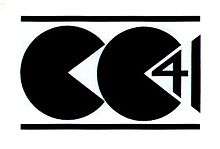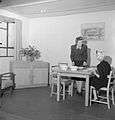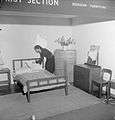Utility furniture
Utility furniture refers to furniture produced in the United Kingdom during and just after World War II, under a Government scheme which was designed to cope with shortages of raw materials and rationing of consumption. Introduced in 1942, the Utility Furniture Scheme continued into post-war austerity and lasted until 1952.
Background
By 1941 it had become apparent that the combination of a severe lack of timber suitable for furniture making (in which Britain was not self-sufficient) and the increased demand for new furniture due to the losses of housing caused by bombing and to the continuing establishment of new households after marriage, had created a severe furniture shortage.
The Utility Furniture Advisory Committee
The Utility Furniture Advisory Committee was set up in 1942, drawing on considerable expertise, principally Gordon Russell and Ernest Clench, also Herman Lebus and John Gloag, in order to assure that the scarce available resources were used in a sensible way. New furniture was rationed and was restricted to newly-weds and people who had been bombed out, under the "Domestic Furniture (Control of Manufacture and Supply (No 2)) Order 1942" operative from 1 November 1942.

The same logo was used for Utility Furniture as had been developed for the Utility clothing scheme: two capital letters C's and the figure 41, for "Controlled Commodity 1941" (which soon became known as "The Two Cheeses").
Utility Furniture Catalogue
The Committee produced a number of approved designs, published in the Utility Furniture Catalogue of 1943. The aim was to ensure the production of strong well-designed furniture making the most efficient use of the scarce timber. The designs were largely in the tradition of the Arts and Crafts movement, and were severe in their simplicity and lack of ornamentation, entirely contrary to popular taste of the immediate pre-war period. Furniture based on these designs was constructed by about 700 firms around the country. Given the huge number of individual manufacturers involved, it is perhaps not surprising that quality varied enormously.
The Committee were reconstituted as the Utility Design Panel in 1943 with Gordon Russell as Chairman;[1] and in 1946, in conjunction with the important exhibition of post-war design, "Britain Can Make It", unveiled three new furniture ranges (Cotswold, Chiltern and Cockaigne) intended to carry forward the best of their design ethos into the postwar period.
Demise
The Committee were genuine believers in the aesthetic qualities of their designs, however, popular hankering for ornament manifested itself almost immediately, and instances were apparently reported of black market utility furniture with added carvings and decoration. Design rules were relaxed in 1948 and the "Diversified" range was announced, drawing on contemporary Scandinavian designs, but the tide of public taste was against it and the Panel was wound down. The scheme was officially closed in 1952, the same year that furniture rationing ceased.
Gallery
 Living room furniture at the Utility Furniture Exhibition, the Building Centre, London, 1942.
Living room furniture at the Utility Furniture Exhibition, the Building Centre, London, 1942. Bedroom furniture at the same exhibition.
Bedroom furniture at the same exhibition. Applying for a "Household Buying Permit".
Applying for a "Household Buying Permit". Receiving the permit.
Receiving the permit. Making the purchase from a catalogue of utility furniture.
Making the purchase from a catalogue of utility furniture.
References
- ↑ Woodham, Jonathan M. (1997) Twentieth-Century Design. Oxford: Oxford University Press, p. 118. ISBN 9780192842046
Further reading
- Richard Sword - Utility furniture and fashion, 1941–1951 (1974) ISBN 0-7168-0628-2
- Jon Mills - Utility Furniture - The 1943 Utility Furniture Catalogue with an explanation of Britain's Second World War Utility Furniture Scheme (2008) ISBN 978-0-9552723-2-5
External links
| Wikimedia Commons has media related to Utility furniture. |
- Designing Britain 1945-1975: the visual experience of post-war society
- Making the Modern World (Science Museum)
- Utility Furniture - Some Memories